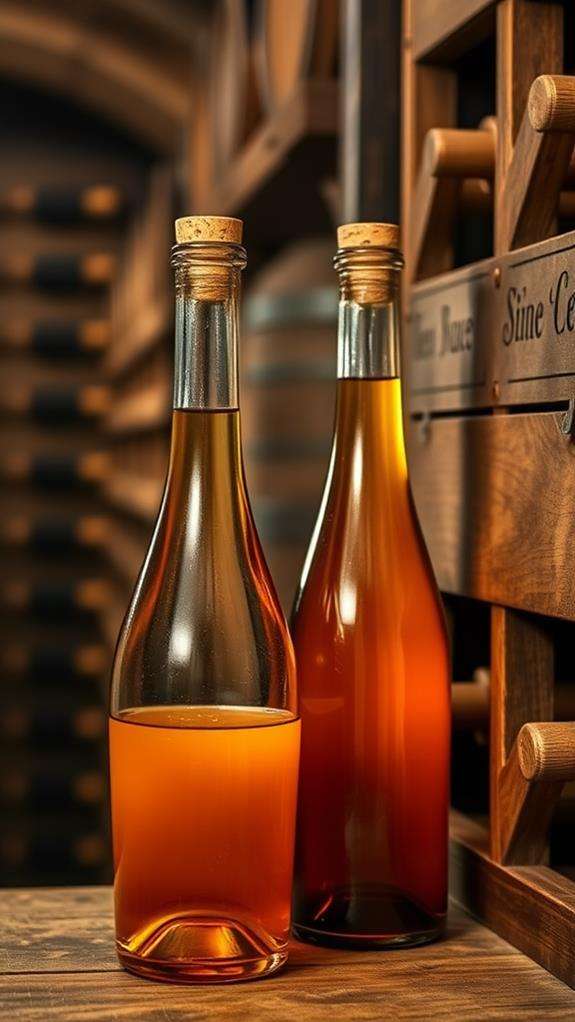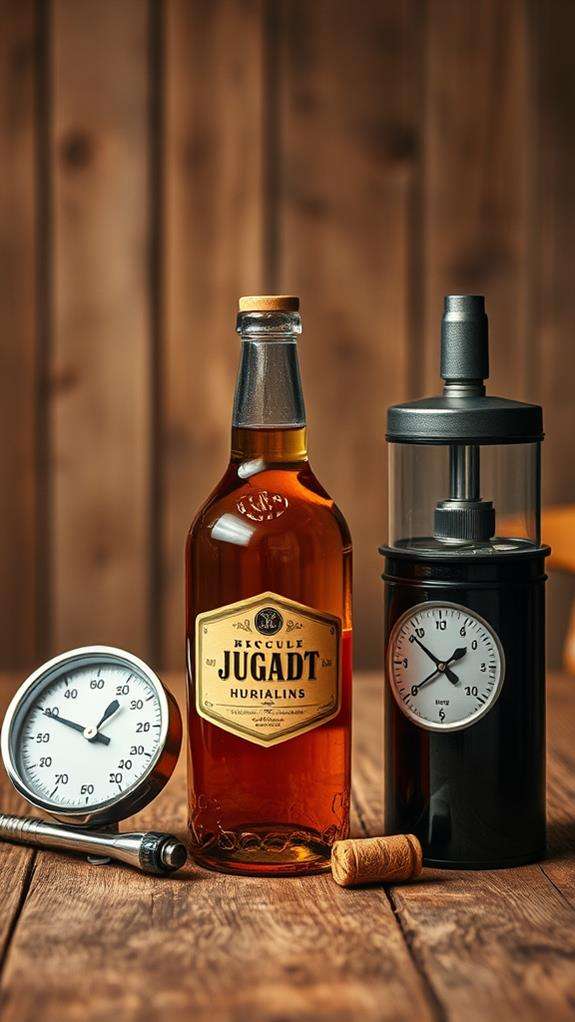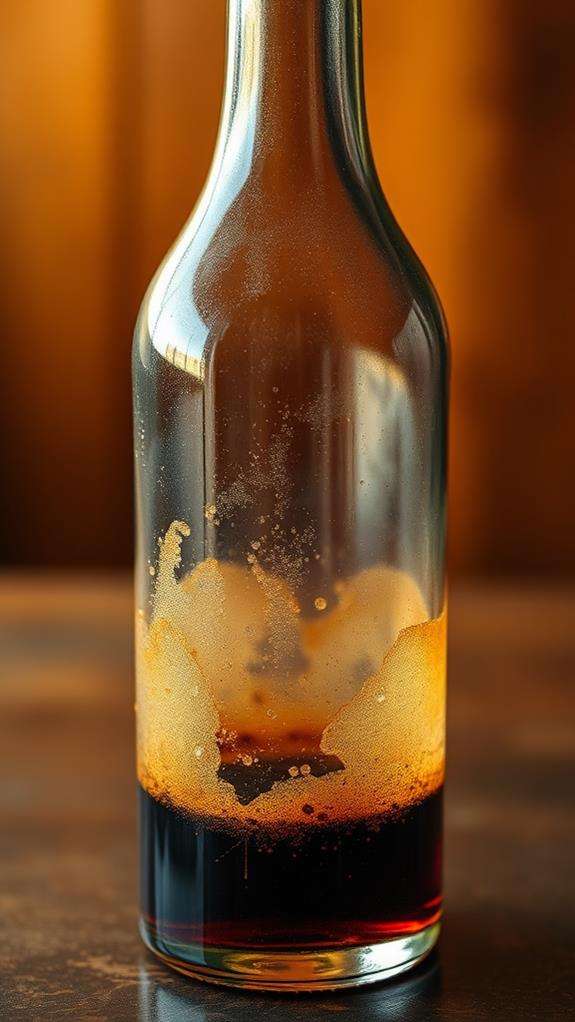How Long Does Mead Last After Opening
Once opened, your mead will typically remain drinkable for 4-6 weeks, though its quality starts declining within days of oxygen exposure. You'll get the best results by storing it at 55-65°F (13-18°C) in a cool, dark place and using proper sealing methods like vacuum stoppers or inert gas sprays. Higher alcohol content (14%+ ABV) and residual sugar levels can extend shelf life, while proper refrigeration at 45-65°F (7-18°C) helps slow oxidation and bacterial growth. Watch for signs of spoilage like cloudiness, unusual particles, or vinegary smells. Understanding proper storage techniques can markedly extend your mead's enjoyment window.
This post may contain affiliate links. If you make a purchase through these links, I may earn a commission at no additional cost to you. Additionally, portions of this post may be generated using artificial intelligence (AI) technology. While we strive for accuracy, please be aware that AI-generated content may not always be perfect and should be fact-checked when necessary.
The Spatula Scoops
- Opened mead typically lasts 1-2 months when properly stored, with high-alcohol varieties lasting longer than lower ABV versions.
- Store opened mead in the refrigerator at 45-65°F (7-18°C) to slow oxidation and bacterial growth.
- Transfer mead to smaller containers with minimal headspace to reduce oxygen exposure and preserve quality longer.
- Signs of spoilage include cloudiness, vinegary smells, or bitter tastes, indicating the mead should be discarded.
- Use vacuum stoppers or inert gas sprays after each pour to minimize oxygen exposure and extend shelf life.
Understanding Mead Storage Basics

Before diving into shelf life, proper storage is essential for maintaining mead's quality and flavor. When you're storing mead, you'll need to take into account three key factors: temperature, light exposure, and bottle position. Your mead should be kept in a cool, dark place, ideally between 55-65°F (13-18°C), as higher temperatures can accelerate aging and potentially compromise the taste.
You'll want to store your bottles horizontally if they've got natural corks, which keeps the cork moist and prevents it from drying out and shrinking. However, if you're using synthetic corks or screw caps, vertical storage is perfectly fine. Light exposure, particularly UV rays, can be detrimental to your mead's quality, so you'll need to keep bottles away from direct sunlight and fluorescent lighting.
The storage area should maintain consistent humidity levels, as extreme fluctuations can affect the cork's integrity and potentially lead to oxidation. If you've got a wine cellar or dedicated beverage fridge, that's ideal, but a dark cabinet or closet away from heating vents will work well too, provided it meets these basic requirements.
Factors Affecting Opened Mead Lifespan

Once opened, several key factors influence how long your mead will stay fresh and enjoyable. The alcohol content (ABV) plays an essential role, as higher alcohol levels act as a natural preservative, extending your mead's shelf life. You'll find that meads with 14% ABV or higher typically last longer than those with lower alcohol content.
Storage temperature greatly impacts your opened mead's longevity. You should keep it between 55-65°F (13-18°C), as warmer temperatures accelerate oxidation and flavor deterioration. The amount of residual sugar also affects preservation, with sweeter meads generally showing greater stability than dry varieties.
The bottle's exposure to oxygen becomes critical after opening. You'll want to minimize air contact by using wine preservation tools like vacuum stoppers or inert gas sprays. The container's seal quality matters too – a tight-fitting cork or cap helps prevent contamination and oxidation. Additionally, light exposure can trigger chemical reactions that alter your mead's taste, so you should store opened bottles in a dark place. The initial quality and craftsmanship of your mead will also determine how well it maintains its characteristics post-opening.
Proper Storage Methods

Proper storage techniques can greatly extend your opened mead's lifespan. To maintain your mead's quality, you'll need to focus on three key storage elements: temperature, light exposure, and container selection.
Store your opened mead in a cool, dark place where temperatures remain between 45-65°F (7-18°C). Your refrigerator is ideal, as it'll slow down oxidation and preserve the mead's flavors. If you don't have fridge space, choose a basement or wine cellar that maintains consistent temperatures and humidity levels.
You'll want to transfer your mead to an airtight container if the original bottle doesn't seal properly. Consider using a swing-top bottle or a clean wine bottle with a fresh cork. Always verify there's minimal headspace in the container, as air contact accelerates degradation. If you're storing multiple bottles, use wine preservation systems like vacuum pumps or inert gas sprays to remove oxygen from partially filled containers.
Keep your mead bottles upright rather than on their sides, and avoid areas with temperature fluctuations like near stoves or sunny windows. Remember to clean all storage containers thoroughly and check for any signs of contamination before transferring your mead.
Signs of Spoiled Mead

Even with careful storage, you'll need to know how to spot spoiled mead before consuming it. Your mead's appearance, smell, and taste can reveal whether it's still safe to drink or has turned bad. When examining your mead, look for any significant changes in color, cloudiness, or particles that weren't present when you first opened the bottle.
- If you notice fuzzy growths, film on the surface, or unusual sediment that wasn't there before, your mead has likely developed harmful bacteria or mold
- A sour, vinegary smell or sharp, acetic aroma indicates that your mead has oxidized and fermented beyond its intended state
- Any off-putting tastes, particularly bitter or medicinal flavors that weren't present initially, suggest your mead has spoiled
You'll want to trust your senses when evaluating mead quality, as they're your first line of defense against consuming spoiled alcohol. If you're uncertain about your mead's condition, it's better to err on the side of caution and dispose of it. Remember that properly stored mead shouldn't develop new flavors or characteristics after opening, so any significant changes are red flags.
Extending Your Mead's Shelf Life

Taking steps to preserve your opened mead can greatly extend its drinkability beyond the initial uncorking. You'll want to store your mead in the refrigerator immediately after opening, as cooler temperatures notably slow down oxidation and bacterial growth.
To maximize shelf life, transfer your mead to a smaller container when the original bottle is half-empty. This reduces the amount of oxygen that can interact with the liquid, preventing premature aging and off-flavors. You can use swing-top bottles or wine preservers with rubber stoppers for the best results.
Always make sure you're resealing the bottle tightly after each pour, and consider investing in a vacuum pump system to remove excess air from partially filled bottles. If you're storing traditional mead (without fruit additions), you can expect it to maintain quality for 1-2 months when properly stored. For meads with higher alcohol content (above 14% ABV), you'll often get even longer storage times due to the natural preservative effects of alcohol.
Don't forget to keep your mead away from direct sunlight and store bottles upright once opened to minimize the surface area exposed to air.
Best Serving Practices

You'll get the most enjoyment from your mead when serving it at the right temperature, typically between 55-65°F (13-18°C) for traditional meads and slightly cooler for fruit varieties. After serving, promptly re-cork your opened bottle and store it in the refrigerator at around 40°F (4°C) to maintain its quality between pours. To guarantee the best flavor profile in subsequent servings, let your chilled mead warm slightly in the glass for about 10-15 minutes before drinking, allowing its complex aromatics to fully develop.
Optimal Temperature Guidelines
For ideal enjoyment of mead, serving temperature plays an essential role in bringing out the beverage's complex flavors and aromas. You'll want to store and serve your mead at different temperatures depending on its variety and sweetness level, much like you would with wine.
Traditional meads typically show their best characteristics when served between 55-65°F (13-18°C), though this can vary based on the specific style. You'll find that lighter, fruitier meads often taste better when served slightly cooler, while fuller-bodied, higher-alcohol varieties benefit from slightly warmer temperatures.
- Light, sweet meads should be served at 45-50°F (7-10°C) to enhance their crisp, invigorating qualities
- Medium-bodied traditional meads perform best at 55-60°F (13-16°C), allowing their honey characteristics to shine
- Heavy, complex meads should be served at 60-65°F (16-18°C) to fully express their intricate flavor profiles
If you're serving chilled mead, remove it from the refrigerator 15-20 minutes before drinking to allow it to reach its ideal temperature. You'll notice that as the mead warms slightly, additional aromatic compounds become more pronounced, creating a more complete tasting experience.
Storage Between Servings
Once you've mastered serving temperatures, proper storage between pours becomes the next key factor in maintaining your mead's quality. For ideal preservation, you'll want to re-cork or reseal your mead bottle immediately after each pour, reducing exposure to oxygen that can degrade the flavors and aromatics.
Between servings, you should store your opened mead bottle upright in the refrigerator, which helps slow down oxidation and maintains the beverage's integrity. If you're using a natural cork, consider investing in a vacuum pump stopper or high-quality rubber stopper to create an airtight seal. For screw-cap bottles, verify you've tightened the cap firmly after each use.
When you're planning to return to your mead within a few days, storing it at 45-55°F (7-13°C) in your refrigerator will suffice. However, if you don't expect to finish the bottle within a week, consider transferring the remaining mead to a smaller container to minimize the air space above the liquid. This practice, known as volume reduction, greatly extends your mead's drinkable lifespan by limiting oxidation exposure.
Frequently Asked Questions
Can I Cook With Opened Mead Instead of Throwing It Away?
You're in luck – don't let that opened mead go to waste! You can definitely cook with it, just as you'd use wine in recipes. It's perfect for marinades, sauces, and glazes, especially for poultry or pork dishes. The honey notes in mead can add unique sweetness to your cooking. Try using it to deglaze pans, create reductions, or add depth to braised dishes. Just remember that, like wine, the alcohol will cook off.
Does Freezing Opened Mead Affect Its Alcohol Content?
Freezing won't noticeably affect your mead's alcohol content. When mead freezes, the water content forms ice crystals while the alcohol remains liquid, as ethanol's freezing point is much lower (-173.2°F) than water's. You might notice a slight concentration of alcohol in the unfrozen liquid, but it's minimal. However, freezing can affect the mead's taste and texture, so it's not recommended for preserving opened mead.
Can I Mix Different Types of Mead After Opening Them?
You can mix different types of mead after opening them, but you'll want to contemplate their flavor profiles and sweetness levels. Just like mixing wines, combining a dry mead with a sweet one might create an unbalanced taste. It's best to mix similar styles together – traditional with traditional, or fruit meads with complementary flavors. If you're experimenting, start with small amounts to test the combination before mixing larger quantities.
Will Adding Fruit to Opened Mead Speed up Spoilage?
Like a ripple disturbing still waters, adding fruit to your opened mead will indeed accelerate spoilage. You're introducing new sugars and potential wild yeasts that'll jumpstart fermentation and bacterial growth. If you're set on adding fruit, you'll want to consume the mead within 1-2 weeks, storing it in the refrigerator. You'll notice it's best to drink fruit-infused mead sooner rather than later to avoid off-flavors and potential fermentation issues.
Does the Color Change of Opened Mead Indicate a Change in Flavor?
Color changes in your opened mead can indeed signal flavor alterations. You'll notice that as mead oxidizes, it may darken or take on brownish tints, which often indicates that the flavor profile has shifted. These changes typically result in less vibrant, more muted flavors and potential off-notes. While slight color variations don't always mean your mead has spoiled, they're a reliable indicator that the taste won't be as fresh as when first opened.





